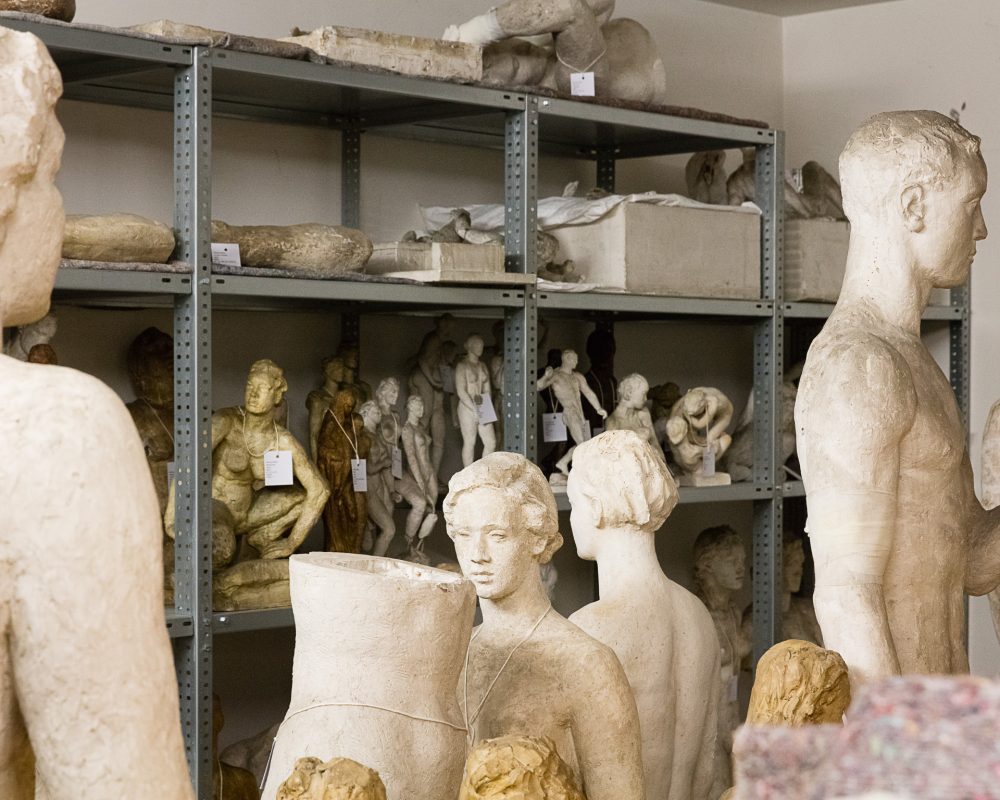Research
Since its foundation, the Georg Kolbe Museum has been actively working on the care and processing of Georg Kolbe’s artistic and written legacy, which, in the history of sculpture, is notable as is one of the most extensive artist’s estates in existence. The museum also sees itself as a research centre for the history of modern sculpture. A particular focus is the inclusion of female voices of early modern sculpture in Germany, which are represented in the museum with works by Renée Sintenis, Emy Roeder, Milly Steger, Genni Wiegmann-Mucchi and Marg Moll, among others. Thanks to numerous important partial bequests to the museum collection, it is possible to take a comprehensive look back at the history of sculpture in the first half of the 20th century.
Current Research Projects:
Cataloging the Sculptures
The museum is currently compiling a comprehensive catalogue of Georg Kolbe’s sculptures, which will classify and summarise the result of research carried out by the Georg Kolbe Museum over the last few decades. It will present and make digitally accessible around 800 works at the beginning of 2024. Networked with the contents of the museum’s collection, which can already be accessed online, the catalogue will provide a comprehensive insight into the work of one of the most influential German sculptors of the last century. Designed as an ongoing research project, it will be continuously updated and expanded.
Project lead: Thomas Pavel
The catalogue of sculptures is being realised with the kind support of the Hermann Reemtsma Foundation and the Ernst von Siemens Art Foundation.
Dr Ursel Berger is providing scientific expertise on individual works by Kolbe. Enquiries can be addressed to Thomas Pavel.
The ‚Second‘ Estate of Georg Kolbe
A significant part of Georg Kolbe’s written legacy was brought to Vancouver in the 1970s by Kolbe’s granddaughter, Maria von Tiesenhausen, where she lived until her passing in 2019 at the age of 90. She ran the Georg Kolbe Museum from 1969 to 1978. A review of her estate revealed a large number of documents and works by the artist that had been with her in Canada and belonged to the collection of the Georg Kolbe Foundation. With the return of this collection to Germany in Spring 2020, Georg Kolbe’s estate has been reunited for the first time in over 50 years. For the history of 20th century art, this is an extremely important find that is unrivalled in terms of quantity and quality. The objects found in Canada form an essential part of Kolbe’s estate. They allow the artist to be understood anew and in a more precise way, not only in terms of his working processes and artistic ambitions, but also as a personality. The documents cover the period from around 1900-1947 and thus the most decisive decades of the 20th century in German and European history. They provide important information about the reality of an artist’s life during these years, about which previously very little was known. More information.
The academic processing of the partial estate is being realised with the generous support of the Hermann Reemtsma Foundation, the Ernst von Siemens Art Foundation, the Berlin Senate Department for Culture and Social Cohesion, the Federal Government Commissioner for Culture and the Media and the Coordination Office for the Preservation of Written Cultural Heritage.
Project lead: Dr Elisa Tamaschke
Georg Kolbe and National Socialism. Continuities and Breaks in Life, Work and Reception
An in-depth examination of Georg Kolbe’s artistic work and social interactions under National Socialism has long been desired. In order to do justice to this important area of research, the museum invited an external panel of experts in Autumn 2021 to examine the sculptor’s self-marketing strategies, his dealings with the art market, his public and private commissions and his participation in exhibitions between 1933 and 1945, among other topics. This research was carried out based on unrestricted access to the documentary estate, which was reunited in 2020. The results were presented at a conference in September 2022. A year later, the contributions appeared in the publication Georg Kolbe and National Socialism. Breaks and Continuities in Life, Work and Reception, published by Gebr. Mann Verlag. More information.
The conference publication is available from the museum shop, bookshops or via the publisher.
The conference and publication were realised thanks to the generous support of the Hermann Reemtsma Foundation, the Ferdinand Möller Foundation, the Ernst von Siemens Art Foundation and the Friends of the Museum.
Project leaders: Dr Julia Wallner and Dr Elisa Tamaschke
Cataloguing the Museum Collection
Since 2013, Georg Kolbe’s artistic estate has been scientifically catalogued, digitised and successively published via the museum’s own Kolbe Online database and in the German Digital Library (DDB) with the financial support of the State of Berlin. In addition to Kolbe’s sculptures, drawings, plaster models and prints, the extensive collection of historical photographs, which impressively document the creative process of his art, will also be made accessible. More information
Project leader: Carolin Jahn



